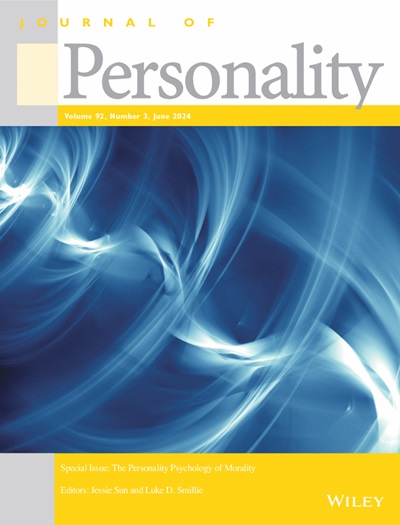超越FFM/Big5的人格建构预测:基于数字表型的探索。
IF 2.7
1区 心理学
Q1 Psychology
引用次数: 0
摘要
目的利用智能手机生成的数据量化人格建构的个体差异,将数字表现型应用于人格研究。它可以被概念化为经验采样方法(esm)的扩展,因为它允许连续的,现场收集行为和上下文数据。本研究在FFM/Big5模型的基础上扩展到包括气质和个人价值理论在内的16种人格结构的59种特征/类型。方法在7-10天内从104名参与者的智能手机上收集数字足迹。采用假设检验(演绎)和机器学习(归纳)方法对数据进行分析。结果在r≥0.34的预测阈值下,成功预测成人依恋、FFM/Big5、痛苦容忍和创造力4个人格结构16个(25%)(r 0.034-0.53)。总体而言,在16个构念的59个个体特征和类型中,成功预测22个(37.29%)。梯度增强树是最有效的机器学习预测模型(与决策树、随机森林和支持向量机相比),特别是在分析与通信相关的信息特征时。结论:本研究证明了智能手机数据的数字表型(Digital Phenotyping)能够拓宽远程人格心理学研究的可能性,并突出了其在People Analytics研究和其他跨学科学术领域的潜在适用性。本文章由计算机程序翻译,如有差异,请以英文原文为准。
Personality Constructs Predictions Beyond FFM/Big5: A Digital Phenotyping-Based Exploration.
OBJECTIVE
The application of digital phenotyping in personality research leverages smartphone-generated data to quantify individual differences in personality constructs. It can be conceptualized as an extension of Experience Sampling Methods (ESMs), as it allows for the continuous, in situ collection of behavioral and contextual data. This study expands beyond the FFM/Big5 model to include 59 traits/types from 16 personality constructs, including temperament and personal value theories.
METHOD
Digital footprints were collected from 104 participants' smartphones over 7-10 days. Both hypothesis-testing (deductive) and machine learning (inductive) methods were applied to analyze the data.
RESULTS
Four personality constructs of 16 (25%) were successfully predicted (r 0.034-0.53): Adult Attachment, FFM/Big5, Distress Tolerance, and Creativity, given an adopted r ≥ 0.34 threshold for successful predictions. Overall, a total of 22 out of 59 individual traits and types of the 16 constructs were successfully predicted (37.29%). Gradient Boosted Trees emerged as the most effective machine learning predictive model (compared with Decision Tree, Random Forest, and Support Vector Machine), particularly when analyzing communication-related information features.
CONCLUSIONS
This study demonstrates the capacity of Digital Phenotyping of smartphone data to broaden the possibilities of remote personality psychology research and highlights its potential applicability in People Analytics research and additional cross-disciplinaryscholarly fields.
求助全文
通过发布文献求助,成功后即可免费获取论文全文。
去求助
来源期刊

Journal of Personality
PSYCHOLOGY, SOCIAL-
CiteScore
9.60
自引率
6.00%
发文量
100
期刊介绍:
Journal of Personality publishes scientific investigations in the field of personality. It focuses particularly on personality and behavior dynamics, personality development, and individual differences in the cognitive, affective, and interpersonal domains. The journal reflects and stimulates interest in the growth of new theoretical and methodological approaches in personality psychology.
 求助内容:
求助内容: 应助结果提醒方式:
应助结果提醒方式:


